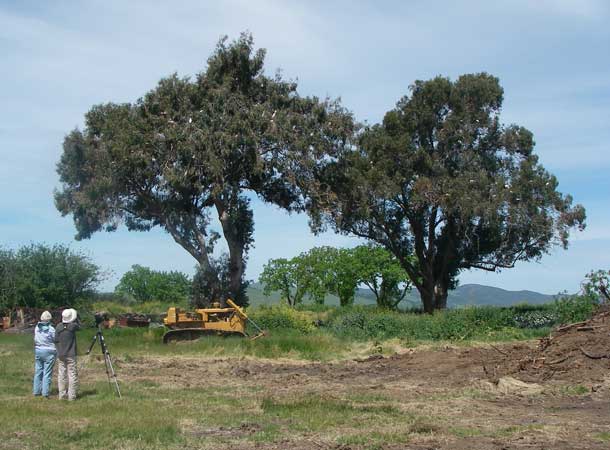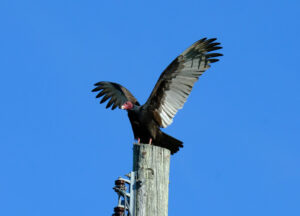One blustery day in April I ride with wetlands ecologist Jude Stalker to F.P. Smith’s Equipment Company, a used farm equipment yard near the town of Cordelia. Scrubby grassland surrounds the property, but Suisun Marsh is less than a half mile to the east. A dirt road cuts through a field of thigh-high wheat near the entrance, then winds past neat rows of John Deere motors and shelves of rusty bits that would only make sense to a farmer hunting for treasure. But we aren’t looking for tractor parts.
- Volunteers monitor this colony of herons and egrets on a ranch near Cordelia. Photo by Jude Stalker.
Finally we reach our destination: a massive brush pile and a pair of towering eucalyptus trees. Jackrabbits dart in and out of the brush, songbirds chatter noisily and gusts of wind nip at our jackets as we crane our necks and stare through binoculars into the sickle-shaped foliage.
The trees are alive with birds, dotted with what resembled large cotton balls: great and snowy egrets that have come to breed. Most of the great egrets had claimed their nest platforms and are now quietly incubating eggs. The snowies, on the other hand, arrived more recently and are still competing for mates and nest sites. They are agitated and vocal. And beautiful. With their wispy white breeding plumes and golden feet, they remind me of a troupe of feisty ballerinas.
“Look at all these snowies!” Stalker says. “I hardly saw any last year.”
For the second year in a row Stalker is participating in the heron and egret nest monitoring program, a collaborative effort between Audubon Canyon Ranch (ACR) and the San Francisco Bay Bird Observatory (SFBBO). Since 1991 the program has been collecting data on the 150 or so heronries scattered throughout the nine-county Bay Area.
Great blue herons, great egrets, snowy egrets, and black-crowned night herons all nest around San Francisco Bay, as do a smaller number of cattle egrets and little blue herons. The heronries vary in size, from just a few nests to well over a hundred. Half are on public land; the other half, like the site Stalker is monitoring, on private property. Some birds choose surprisingly developed and urban settings to raise their young.
Though each species has slightly different preferences, most choose trees close to the wetlands that supply the birds with a buffet of fish, crustaceans, insects, and frogs. Over half the colonies are in nonnative eucalyptus trees.
“In general, the bigger the bird, the taller the tree,” says Emiko Condeso, an ecologist and mapping specialist for ACR who helps coordinate the program.
Condeso relies heavily on people like Stalker. Between 50 and 70 volunteers participate every year, and some have been involved since the program’s inception.
Volunteers don’t have to necessarily be expert birders, says Condeso. “It’s more important to be patient and detail-oriented. And of course they should love herons and egrets.”

- Herons and egrets don’t seem to mind the jumble of old farm equipment that surround the eucalyptus trees where the birds build their nests. Photo by Jude Stalker.
At Stalker’s site, the Pete, Cindy, and Emily Smith Ranch, no chicks have hatched yet, and I have missed the courtship and territorial displays of the great egrets. Many of the birds are simply lying on their nests; at times all we can see is a mound of white peeking over a twiggy platform, or a spray of breeding plumes–called “aigrettes”–fluttering gently in the breeze. Often the incubating bird’s mate roosts nearby, ready to take a shift, though a few are still building or tweaking their nests.
An egret’s nest is a messy affair, a large mass of twigs, some quite large. Egrets and herons share the duties of incubating eggs and feeding chicks. Once they lay their eggs, one adult always remains at the nest until the chicks are about three weeks old.
In general, great blue herons breed earliest. Great egrets begin laying eggs in late March and incubate them for about 25 days, which meant that chicks might start hatching any day now.
“It’s going to get a lot noisier,” Stalker assures me.
Monitoring protocol requires counting the total number of nests for each species; in addition, observers choose several “focal nests” and gather more detailed data about them throughout the season. This information helps determine the rate of survival: how many chicks successfully hatch and live for a certain period of time afterwards. Typically, not every chick survives. The hatching times are staggered, leaving the younger, smaller chicks at a disadvantage if there’s not enough food to go around.
During her initial visit in March, Stalker created a “nesting panorama,” an enlarged photograph of the two trees marked with numbered blue stickers indicating great egret nests, about 30 in each tree at that point. There are many more than that today. I soon learn first-hand why Condeso cites patience as a requisite for nest monitoring.
As I study the photograph and the tree, every burl and branch gains significance. I quickly learned to triangulate, locating nests relative to particular branches, bunches of foliage and each other. Sometimes the birds distract me. I can’t help but follow a great egret as it flies to a nearby walnut tree and carefully breaks off a large twig with its beak, or watching a noisy pair of snowy egrets copulating. One great egret stands abruptly, pokes a long beak down into the nest, and carefully turns an egg. Stalker is watching, too.
“Wait–is that a chick?” she says.
“Where?” I stare intently through my binoculars, hoping to see what could be the first great egret chick hatched in the heronry this year. But after turning the egg, the adult egret settles back down on the nest.
We did find other surprises. The more time we spend staring into the foliage, the more stocky silhouettes we spot: black-crowned night herons. In contrast to the boisterous snowy egrets, the herons roost singly and silently. Then I spy a pair standing side by side on a modest platform squeezed between several great egret nests. Stalker finds another pair, and we start adding red stickers to the panorama.
Numbers at individual heronries fluctuate from year to year; for instance, no great egrets nested at the Gold Hill site in 2000, but in 2002 observers counted over 100 active nests. Condeso says that in general, great blue heron and great egret populations are stable to increasing. It’s harder to draw conclusions about snowy egrets and black-crowned night herons because there’s not as much data available. Both species prefer to nest on islands, and the cryptic night herons often nest in dense shrubs and are simply harder to find.
The data that Stalker and other observers collect are compiled in the “Egret Atlas,” a resource available to biologists, land managers, and curious citizens. The atlas outlines the monitoring protocol, provides a region-by-region summary of every nesting site, and shows where the most important nesting sites are. Biologists at ACR’s Cypress Grove Research Center also interpret the data and regularly publish scientific papers. Among the questions researchers are hoping to answer include how birds respond to changes in weather patterns, and what that might indicate for the ecosystem as a whole.
“Not only are egrets and herons charismatic icons of wetlands, they’re also good indicators of wetlands,” says Condeso.
After several hours we’ve located all the focal nests and added to the constellation of red and blue dots on the nesting panorama. Protocol requires Stalker to come back at least three more times through the nesting season, which can extend into June, but she will probably return even more frequently.
“I love coming out here,” Stalker says. “It’s a world unto itself.”
I can understand why people like her get hooked on herons. As for me, the promise of downy egret chicks might lure me back to Pete Smith’s yard sooner than later.
“It’s the best of citizen science,” says Condeso. “Plus you get to watch baby birds.”
Find out more about volunteering with SFBBO or Audubon Canyon Ranch.

.jpg)




